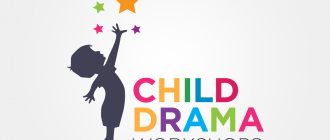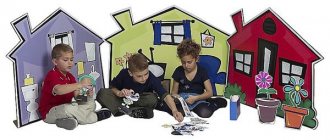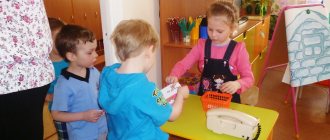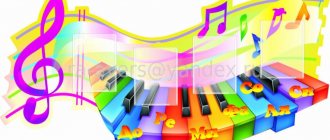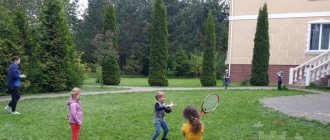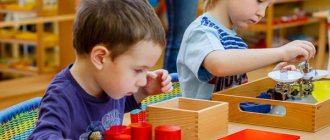Developing mathematical knowledge is not just learning to count
We live in an age of technology. Mathematical knowledge and much related to the exact sciences are needed for everyday life. It's not even a matter of:
- be able to count (minimum);
- know complex mathematical formulas by heart (maximum).
The general concept of the development of mathematical abilities in preschool children is presented in the works of researcher A.V. Beloshistaya. The author explains what we should mean in the words “development of mathematical abilities.” These are skills that will invariably come in handy to:
- be able to look for new solutions;
- deeply understand the essence of a phenomenon or fact;
- build logical connections;
- see the problem as a whole.
Agree, a lot! According to Beloshistaya, math classes in kindergarten should develop the child intellectually. And also prepare him to understand mathematical and logical information at school. Preparation – work with both motor skills and the development of logical structures.
Mathematics gives not just knowledge, but develops a special style of thinking. This science provides enormous potential for the formation of intelligence from kindergarten age. There is no time to waste; the most important mental logical structures are organized at the age of 5-11. This means that emphasis should be placed on mathematics from the senior group of kindergarten. But it is possible earlier.
There are games and activities that teach children to direct their thinking in a logical direction from the age of 2-3. A child may still speak poorly, but can already solve intellectual problems (for his age). The book “Formation of elementary mathematical concepts in kindergarten” suggests studying with children 2-7 years old. It offers methods and examples of classes. The book appears and disappears in the “Labyrinth” - you need to have patience to “catch it”.
For the middle group (4-5 years old) there is a publication entitled “Formation of elementary mathematical concepts” . It contains tasks and game exercises, you can directly take them and use them. The main part of the literature devoted to the development of mathematical thinking is designed for 5-6-7 years, we will return to it.
Kindergarten teachers are given an important task - to awaken interest in mathematics. This can be done through entertaining gaming activities. The process will not go far without self-education at home. There is an endless field of activity for parents here.
Diagnosis by FEMP in the older group
Carrying out diagnostics involves monitoring the quality of education of each student individually. The lesson is based on individual communication between the teacher and the child.
How to quickly teach children to tie their shoelaces with a bow
The teacher gives each student a task in turn and observes the process of thinking and the result obtained. In the process of such diagnostics, children perform tasks of the following nature:
- Name all the geometric shapes located on the desktop. If the child finds it difficult to name the figure, the teacher poses the question differently: asks to point to the figure he is naming.
Important! Children often forget the names of shapes due to excitement, but they know exactly what it looks like when they hear the name.
- Arrange identical objects in order of increasing or decreasing length. The teacher can suggest the student an algorithm of actions by asking leading questions: “Which subject is the longest of the remaining ones?” Answering this question, it will not be difficult for the child to put them in order.
- Be able to count the number of objects, one more or less than the teacher shows. For example, when a preschooler is shown a picture of six squirrels, he must count seven nuts.
- Build a regular pyramid of cubes or cylinders so that the base is the widest object and the top is the narrowest. The teacher is allowed to hold the pyramid and adjust the placed blocks so that they do not fall.
- Carry out entertaining gymnastics without hesitation: the preschooler, at the request of the teacher, shows with his left or right hand other paired organs and parts of the body - ears, cheeks, eyes, eyebrows, etc., from the side that the teacher names.
- After forming a column, the children must name the person in front and the one standing behind. Guys should not stand closer than a meter from each other.
Children lined up in a column
- List the names of the parts of the day; leading questions are allowed, for example: “When are you going to kindergarten, what time of day is it?”
- Name the days of the week in order. When a child finds it difficult to answer or makes a mistake, the teacher can ask: “if today is the fourth day of the week, what is it called?”
You don't have to understand how it works. The main thing is to do
The fact that mathematical and logical knowledge must be taught on time has become clear long ago. That is why preschool educational institutions spend so much time on mathematics. This discipline teaches you to think logically and not be afraid to use flexible thinking. The goal of a math program for preschool children is to teach them to grasp relationships and dependencies. And also create designs from objects, words and signs.
System is very important in learning. It is presented in this manual . If you don’t have time to systematize your knowledge, you can take ready-made workbooks for the appropriate age and start studying from them. You don’t even need to particularly understand the theory – you just have to do it. Parents and teachers will be helped by workbooks for 5-6 years old, compiled by Kondratyeva:
- "Math games in pictures for 5-6 years old" . General exercises are given, as well as tasks for the prevention of dyscalculia (impaired counting skills).
- "Counting and comparing numbers within ten" . The goal is the same, the tasks are different.
- . ” All three books are suitable for parents and educators who want to develop children.
Bortnikova produced a good notebook. The publication for 4-6 years old is called “Getting Ready for School. Development of mathematical abilities" . It introduces preparatory group students to geometric shapes, numbers, simple operations, and teaches comparison. The author has many other good books. For example, “Fun puzzles” for the little ones. She will interest younger children with bright pictures and rhymes.
Books by Yulia Glagoleva aimed at intellectual development are popular. The publications include quite complex tasks. From the book “Development of mathematical abilities. 1-2 grades. Federal State Educational Standard" parents sometimes try to give something to older preschoolers. But often it’s too early for them. And from a similar publication for grades 3-4 - even more so. But remember these manuals, they will be useful to schoolchildren.
“FEMP methodology as a scientific discipline. The concept of “mathematical development” consultation on the topic
Consultation
“Methodology for the formation of elementary mathematical concepts as a scientific field. The concept of “Mathematical development of preschool children”
The problem of teaching children mathematics has interested scientists for many centuries. In the 17th-19th centuries. Ya. A. Komensky, I. G. Pestalozzi, K. D. Ushinsky, Montessori and others came to the conclusion about the need for special mathematical training for preschool children. The formation of their knowledge about size, measurement, time and space was considered from the point of view of practical expediency.
Having separated from preschool pedagogy, the method of forming elementary mathematical concepts has become an independent scientific and educational field. The subject of her research is the study of the basic laws of the process of formation of elementary mathematical concepts in preschool children in the conditions of public education.
The methodology for the formation of elementary mathematical concepts in the system of pedagogical sciences is intended to assist in preparing preschool children to perceive and master mathematics - one of the most important academic subjects at school, and to contribute to the education of a comprehensively developed personality.
The range of problems solved by the technique is quite extensive:
- scientific substantiation of program requirements for the level of development of quantitative, spatial, temporal and other mathematical concepts of children in each age group;
- determining the content of mathematical material for teaching children in kindergarten;
- development and implementation into practice of effective didactic tools, methods and various forms of organizing the process of developing elementary mathematical concepts;
- implementation of continuity in the formation of basic mathematical concepts in kindergarten and corresponding concepts in school;
- development of content for the training of highly qualified personnel capable of carrying out pedagogical and methodological work on the formation and development of mathematical concepts in children at all levels of the preschool education system;
- development, on a scientific basis, of methodological recommendations for parents on the development of mathematical concepts in children in a family setting.
The general objective of the methodology is to study and develop practical foundations for the process of forming elementary mathematical concepts in preschool children.
The methodology for forming elementary mathematical concepts in preschoolers is constantly developing, improving and enriching with the results of scientific research and advanced pedagogical experience.
Currently, thanks to the efforts of scientists and practitioners, a scientifically based methodological system for the formation of elementary mathematical concepts in preschoolers has been created, is successfully functioning and is being improved. Its main elements - purpose, content, methods, means, forms of organization of work - are closely interconnected and mutually condition each other. The leading and determining one among them is the goal, since it is socially determined and objective in nature. The kindergarten fulfills the social order of society, preparing children to study the basics of science (including mathematics) at school.
Training and development are in a dialectical relationship. Based on the current level of development, training should be somewhat ahead of it. This means that in the learning process it is necessary to focus not only on what the child himself is capable of doing, but also on what he can do with the help of adults, under their guidance, i.e., on the future, on the “zone of proximal development” , which usually contains new and more complex actions and operations than those that the child already knows.
The concept of “mathematical development of preschool children” is widely used in modern preschool pedagogy and child psychology, in preschool education programs.
The mathematical development of preschoolers should be understood as shifts and changes in cognitive activity that occur as a result of the formation of elementary mathematical concepts and related logical operations.
Taking into account age-related characteristics when children master methods of practical actions, when they master mathematical connections and patterns, continuity in the development of mathematical abilities are the leading principles in the formation of mathematical concepts. The purposeful mathematical development of a preschool child involves, first of all, instilling in him the habit of logically arguing his actions. It is the formation of logical thinking of preschoolers that is most conducive to the study of the principles of mathematics.
The mathematical development of preschoolers occurs both in everyday life (primarily in communication with adults, in joint activities with them and with each other), and through targeted learning.
The goal of mathematical development of preschoolers
- Comprehensive development of the child’s personality.
- Preparing for success in school.
- Correctional and educational work.
Tasks of mathematical development of preschool children
1. Formation of a system of elementary mathematical representations.
- Formation of prerequisites for mathematical thinking.
- Formation of sensory processes and abilities.
- Expanding and enriching the vocabulary and improving connected speech.
- Formation of initial forms of educational activity.
Principles of teaching mathematics:
- Consciousness and activity.
- Visibility.
- Activity approach.
- Systematicity and consistency.
- Strength.
- Constant repeatability.
- Scientificity.
- Availability.
- Connection with life.
- Developmental training.
- Individual and differentiated approach.
- Corrective focus, etc.
L.S. Vygotsky in his works spoke about the “social factor of development.”
A child’s assimilation of elementary mathematical concepts occurs in a certain social environment under the influence of various factors. These factors can be divided into three large groups: micro-, meso-, and macro factors.
- The microenvironment for the development of a child, including his elementary mathematical concepts, is, first of all, the family. It is in the family that he gains his first life experience. The family satisfies the child’s need for primary information of a mathematical nature (spatial-temporal orientation, idea of shape, size, quantity, etc.). Primary experience expands and enriches in communication with peers and other children. Thanks to the microenvironment, the child receives his first mathematical knowledge.
- Mesofactors include ethnocultural conditions. People belonging to the same ethnic group, as a rule, speak the same language, observe the same cultural and everyday traditions, etc. These factors also include climate and geographic location of the settlement. Mesofactors have their own socialization mechanisms. The child assumes exactly the ethnic character that was the first in his life. It becomes the primary source of socialization for the child.
- Macro factors include space, planet, society and state. For the development of mathematical concepts, factors associated with social events that correlate with the calendar, give an idea of time and space, and show children the common roots of all sciences, including mathematics, are of particular importance.
A child’s ideas about the principles of mathematics are formed on the basis of systemic knowledge that he receives in the process of interaction with objects of the surrounding world, with adults and peers. This knowledge can perform different functions in children’s mathematical experience:
- Information function - mathematical knowledge carries any information about quantitative, temporal, spatial, geometric and magnitude relationships. The significance of this function is that the child begins to navigate the world around him. However, in a subjective sense, for each child the concept of information content is ambiguous. This depends on the level of development of certain mathematical concepts in him, on the level of development of cognitive interests that determine openness to information.
- Emotional-cognitive function - manifests itself in interest in the object being studied, emotional uplift during activities with it. In the process of forming elementary mathematical concepts, it is necessary not only to convey information of a mathematical nature to the child, but to present it in such a form, with such emotional overtones, that contribute to the most rapid and complete assimilation of the material.
- Regulatory function – projects knowledge onto specific activities.
Opportunities for the comprehensive development of a child in the process of FEMP
I. Sensory development (sensation and perception) The source of elementary mathematical concepts is the surrounding reality, which the child learns in the process of various activities, in communication with adults and under their teaching guidance. The basis for young children’s cognition of qualitative and quantitative characteristics of objects and phenomena are sensory processes (eye movements tracing the shape and size of an object, feeling with hands, etc.). In the process of various perceptual and productive activities, children begin to form ideas about the world around them: about the various characteristics and properties of objects - color, shape, size, their spatial arrangement, quantity. Gradually, sensory experience accumulates, which is the sensory basis for mathematical development. When forming elementary mathematical concepts in a preschooler, we rely on various analyzers (tactile, visual, auditory, kinesthetic) and simultaneously develop them. The development of perception occurs through the improvement of perceptual actions (looking, feeling, listening, etc.) and the assimilation of systems of sensory standards developed by humanity (geometric figures, measures of quantities, etc.).
II. Development of thinking
Thinking is the process of consciously reflecting reality in ideas and judgments.
In the process of forming elementary mathematical concepts, children develop all types of thinking:
- visually effective;
- visual-figurative;
- verbal-logical.
III. Development of memory, attention, imagination
Memory includes memorization (“Remember, this is a square”), recollection (“What is the name of this figure?”), reproduction (“Draw a circle!”), recognition (“Find and name familiar figures!”).
Attention does not act as an independent process. Its result is the improvement of all activities. To activate attention, the ability to set a task and motivate it is crucial.
Imaginative images are formed as a result of the mental construction of objects (“Imagine a figure with five corners”).
IV. Speech development
Mathematical classes have a huge positive impact on the development of a child’s speech:
- enrichment of the vocabulary (numerals, spatial prepositions and adverbs, mathematical terms characterizing shape, size, etc.);
- agreement of words in the singular and plural (“one bunny, two bunnies, five bunnies”);
- formulating answers in full sentences;
- logical reasoning.
Formulating a thought in words leads to better understanding: by formulating a thought, a thought is formed.
V. Development of special skills and abilities
In mathematics classes, children develop special skills and abilities that they need in life and study: counting, calculation, measurement, etc.
VI. Development of cognitive interests
Used Books:
- Baryaeva L.B., Kondratyeva S.Yu. Mathematics for preschoolers in games and exercises. – St. Petersburg: KARO, 2007;
- Erofeeva T.I. et al. Mathematics for preschoolers. M., 1994.
- Leushina A. M. Formation of elementary mathematical concepts in preschool children: Textbook. manual for students of pedagogical institutes. M.: Education, 1974.
- Formation of elementary mathematical concepts in preschoolers / ed. A.A. Carpenter. - M.: Education, 1988.
Introducing mathematics in a playful way
For a child, everything in the world is a game. And the game is both study and work, and a way of understanding reality. It needs to be included in the educational process. That is, to lead, direct, organize. Thus, it is possible to influence different aspects of the personality: in total, sensations, consciousness, will and behavior.
Children enjoy play activities as a process. Teachers and parents have a different goal. They need to develop a preschooler, put certain knowledge into his head, and develop personal qualities. Didactic games and exercises are especially useful. They provoke relaxed interaction between participants and teach them how to communicate.
Board games are very helpful in forming ideas about forms, sequences, contradictions and other things. They save you right away. You can make cards for such games yourself. But there are ready-made game sets, they are bright and cost a penny. This is for example:
- lotto “Logical tables” for 3-6 years;
- games like “What’s extra?” (there are many options, for example this one from 3 years old and this one for 4-7 years old );
- funny toy “Whose cat is bigger?” to compare numbers;
- "Find a similar figure";
- "Katamino" (mini road version) develops spatial thinking.
Types of classes in FEMP
Classes are held, according to the training manual by Pozina and Pomoraeva, once a week. In September, the first week is reserved for adaptation, so only three lessons are planned this month.
Solving math problems with preschoolers
Integrated classes
The integrated type of training is recognized as the most effective, since there is no direct teaching that can distract the child’s attention and deprive him of passion for the process. In such lessons, familiar cartoon characters are chosen as didactic material, for example, Masha and the Bear, who ask the children to help them make a difficult journey through the country of Mathematics.
The journey is accompanied by meeting new heroes who ask the guys for help in solving a task related to numbers or directions on a map.
Open classes
In open classes, embedded game technology is also used, but to a lesser extent. The lesson is more like a school one. It differs only in that it can be attended by teachers and parents of students. The purpose of the lesson is to demonstrate the skill of the teacher and the success of the children. Before the eyes of those present, a fairy tale is born, leading children through tasks and obstacles to the goal. Often in open lessons, teachers use presentations to illustrate the amount of material learned.
Open lesson on FEMP
Exercises with chopsticks
One of the most informative and accessible methods of teaching children to understand numbers is sticks. To understand the meaning of numbers, it is important not just to remember what it is called and looks like in writing. The whole point of learning to count is to understand how many units there are. Using sticks helps to understand the mathematical meaning of numbers. For comparing numbers with each other, Cuisenaire sticks are best suited, painted in different colors and having different lengths - in accordance with the numerical value of the stick.
Interesting! Each element of the set is visually attractive to the child, due to which acquaintance with numerical values is more effective.
Orientation on a piece of paper
Mandatory exercises on orientation skills on a sheet of paper contribute to all-round development. By the end of the year, children are able to name all the corners, specifying the location of each. Here such spatial concepts as “top”, “bottom”, “left”, “right”, “center” are combined.
Orientation practice sheet
Final lesson
The final lesson on FEPM in the senior group does not imply innovation. The lesson is conducted to consolidate the learned material. Most often, open lessons are held precisely at the final lessons, when the entire course has already been mastered by the children, and the teacher can demonstrate the fruits of his work there.
Didactic material necessarily includes elements of the game: familiar fairy-tale characters, balloons, colorful ribbons of different lengths. Summing up the training, the teacher prepares the lesson in such a way as to touch upon all previously studied topics and check each student how well he perceived the material throughout the year.
Examples of games for developing mathematical concepts
It is not necessary to buy game and educational sets to train structural thinking. You can use available tools: counting sticks, checkers, felt-tip pens and paper.
- Counting sticks will help preschoolers become familiar with the concept of shape. Simple and complex figures are built from the set, which are then easily transformed into each other. But to transform, you need to understand how. For example, from 5 sticks you can make two identical triangles. And from one on the table - one triangle (put it on the corner).
- What if you invite your child to draw a problem? He must come up with a plot, draw it and explain his problem. It just seems simple, but in reality it’s not very simple. This game develops creative thinking, imagination and invention. Kids learn to invent and express their thoughts.
- A simple and exciting game - checkers, preschoolers play with pleasure. Such activities teach you to plan moves, think abstractly, and develop ingenuity. Children who win at checkers often do better in school (our common humble observation). The game can be turned into a family hobby, and it will only bring benefits.
Mathematical riddles will help you master terminology
Another good thing is math-themed riddles. They teach kids independence and perseverance. After all, you often need to not just say the answer, but prove it. The beauty of riddles is that they teach you to use mental operations (synthesize, analyze, compare, generalize). Here are examples of riddles:
I am a dash in grammar, and who am I in mathematics? (Minus)
I have no corners, And I look like a dish, Like a plate and a lid, Like a ring and a wheel. (Circle)
The cunning brothers live in a difficult book. There are ten of them, but these brothers will count everything in the world. (Numbers)
There are also humorous puzzles that teach you to look for answers outside the box. For example: “You and I, and you and me, how many of us are there in total?” (2). “How many ends does the stick have, two, two and a half?” (in the latter case – 6).
Other games for logic and mathematics
Here are a couple of games that will allow preschool children 5-7 years old to get used to numbers. And also - they will consolidate quantitative ideas. You can make a set for classes yourself; these are cards with numbers and colored circles.
- What number escaped? We take several sets of cards with numbers from 0 to 10 and divide the guys into pairs. First, the couple puts the cards in order. Then one of the players closes his eyes, and the second rearranges several cards. When the first one opens his eyes, he should find changes. If found correctly, it starts leading. To make it more difficult, you can offer cards from 0 to 20 or from 10 to 20.
- Find a pair. The game is fun and noisy, so don’t disturb the kids from running around and having fun. We prepare cards with numbers and the corresponding number of circles. We divide the children into 2 teams. We lay out inverted number cards on one table, and with circles on the other. We invite the children to run around and then, at a signal, take cards from the tables. And after that, find a pair: if there is a number on the card, you need to find a child with a card with the same number of circles.
The first game was about seriation - building an ordered series. Rows can be organized according to different criteria: size, length, height, color. You can use pebbles, ribbons, dolls, sticks - literally anything that is at hand at a certain moment.
Synthesis games are very interesting - combining different objects according to a certain characteristic. For example, these are tasks where you need to choose:
- red balls;
- red, but not balls;
- round, but not balls;
- all the balls;
- the largest green ball (two characteristics are combined here - color and size, this is more complicated).
You can play with objects or cards. Another option is to offer to choose a different figure from a range. Or find three triangles in the picture. All these are also synthesis problems.
Another logical technique is comparison. To compare, you need to learn to concentrate on one feature and abstract from others. Let's say these are tasks like “choose the big yellow one”, “choose the big round one”, etc. Moreover, it is easier for kids to first learn the differences and then the similarities.
What material is given on FEMP in the senior group
FEMP in the senior group is focused on broadening one’s horizons, applying the acquired knowledge to everyday life, and having a correct understanding of the world.
Throughout the entire school year at preschool educational institutions, children learn new geometric shapes. By the end of the third quarter, children should distinguish the following shapes: circle, triangle, square, rectangle, oval. Also, ideas about a ball, cube and cylinder are introduced and reinforced. Classes are conducted aimed at training in dividing a circle and square into two and four parts.
Children in the senior group of preschool educational institutions
After division, everyone should be able to name and describe the resulting figures. The children learn to apply the acquired knowledge in geometry in life: they visually select objects of familiar shapes, tell how they are used: for example, they analyze a sheet of paper, determining what shape it is, where its corners are, where its sides are, what shape will be obtained if you bend the sheet in half.
Additional Information! Children develop ideas about the sequence of parts of the day. They skillfully determine morning, afternoon, evening and night. When asked by the teacher at lunchtime about the part of the day, they unmistakably answer “day,” and when asked what will happen after, they answer “evening,” remembering that before that there was morning.
Closer to the beginning of summer, the knowledge of the days of the week is completed. The children reinforce the concept of working days and weekends. They can easily navigate the middle of the week: if today is Wednesday, it means yesterday was Tuesday, and tomorrow will be Thursday.
Counting up to 10 is analyzed. The composition of the number and its nearest neighbors are compared. They learn to collect numbers up to 5 in units. By touch and sound they determine the number of objects (sounds), but no more than seven.
Didactic buttons for counting by touch
The skills of comparing various objects in three dimensions are developed - length, width, height. The smallest of the presented items is chosen as the measuring unit.
They train the ability to use landmarks “in front”, “behind”, “right”, “left”. To do this, they practice changing the direction of movement at the command of the teacher.
Important! Children do not acquire all these skills in one year of classes. Starting from the younger group, they gradually learned the elementary fundamentals of mathematics and the world around them. Education for the senior group is mainly aimed at consolidating the acquired knowledge and applying it in everyday life.
Developing math skills for life
There are many games online and in various educational textbooks for children aged 5-7 years. Often they try to divide them by age - this is justified, but you need to look at the development of a particular child. I would like to recommend a couple more good publications with exciting puzzles:
- A book for gifted children “Developing mathematical abilities” (for 6-7 years). Many interesting tasks from the easiest to the most difficult. Bright pictures and design will interest the child.
- “A complete course of preparation for school. For those who are going to 1st grade . The authors did their best and collected about 600 exercises - on mastering counting, preparing the hand for writing, etc.
For classes to be meaningful, they must be done systematically. Experts advise giving children logic exercises every day, little by little. This will teach the child to reason and draw conclusions, develop quick wits and intelligence. It will also increase self-esteem and arouse interest in studying at school. Basic skills in logic and mathematics will be useful not only in school, but throughout your future life.
It is much easier to interest preschoolers than older children. But by the 3rd-4th grade of school, motivation usually drops. So this favorable time should not be missed!
Developmental environment
The developmental environment is a system of material objects of a child’s activity that functionally model the content of his mental and physical development.
The physical and developmental environment is organized in such a way that every child has the opportunity to freely do what they love. The arrangement of equipment by sectors (development centers) allows children to be grouped into subgroups in accordance with their common interests: design, drawing, handicrafts, theater and play activities, experimentation. Materials that activate cognitive activity are required in the equipment: educational games, toys.
The kindergarten environment should ensure the safety of children's lives, promote the health and strengthening of the body of each child.
When creating a subjective development environment, you need to remember this:
- The environment must perform educational, developmental, nurturing, stimulating, organizing and communicative functions. But most importantly, it should work to develop the child’s independence and amateurism.
- 2. flexible and variable use of space is necessary. The environment must meet the child's needs and interests.
- The shape and design of the items are based on the safety and age of children.
- decorative elements should be easily interchangeable.
Each group should have space for conducting experimental activities with the participation of children.
- When organizing the subject environment in a group room, it is necessary to take into account the patterns of mental development, indicators of their health, psychophysiological and communicative characteristics, the level of general and linguistic development, as well as indicators of the emotional sphere and the sphere of needs.
- the color palette should be represented by warm pastel colors.
- When creating a developmental space in a group room, the leading role of play activities should be taken into account.
- Depending on the age characteristics of the children, the period of study and the educational program, the object environment for the development of the group should be changed.
It is important that the physical environment is an open system, not a closed system, that can adapt and evolve. In other words, the environment not only evolves, but also develops. Under any circumstances, the objective world that surrounds the child must be replenished and updated in order to adapt it to the new way of life of a given age.
Thus, when creating an object-developmental environment for any age group in a preschool institution, it is necessary to take into account the psychological foundations of constructive interaction between participants in the educational process, the design and ergonomics of the modern environment of a preschool institution, as well as the psychological characteristics of the age group for which the environment is intended.
We are talking about the age of the child, he has a need to play, and this must be satisfied, and not because business has its own time and need for entertainment, but because as the child plays, so he will work.”
These words belong to the wonderful teacher Alexander Makarenko, who in his teaching practice paid great attention to children's play.
Game is a type of activity of children, which consists in reproducing the actions of adults and the relationships between them and is aimed at orientation and knowledge of the subject and social reality.
A didactic game is a type of educational activity organized in the form of educational games that implement a set of principles of play and active learning, characterized by the presence of rules, a fixed structure of gaming activity and an assessment system.

